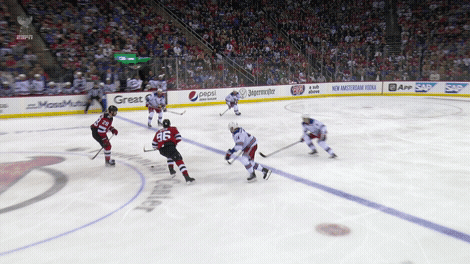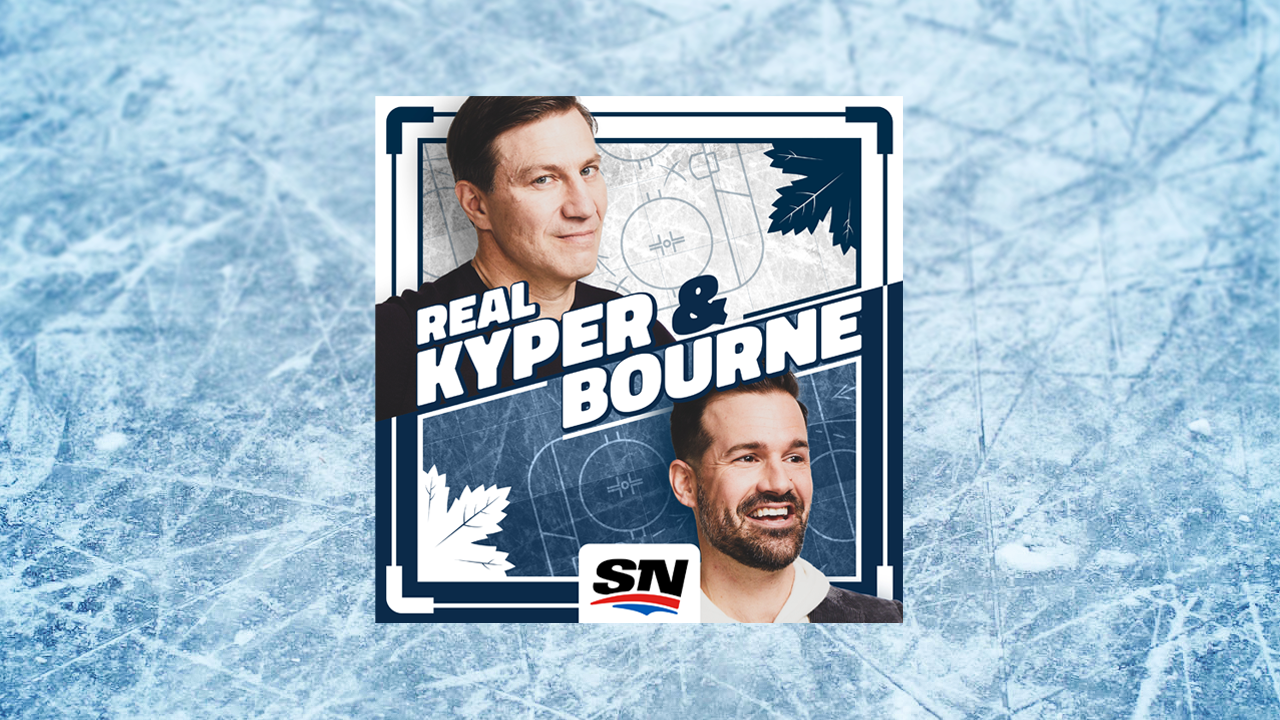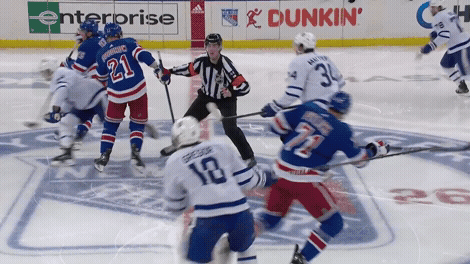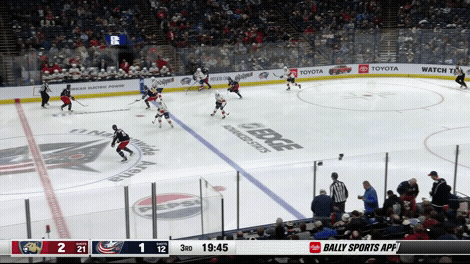
I don’t remember exactly when I first had the thought, but it comes back to me every time Jacob Trouba lands another monster hit: “It’s like he time travelled from the late ’90s to 2020s hockey.” He’s the league’s foremost bundler of opposing forwards, and it seems like that defending style — one of brute force at times — is from a version of the NHL that’s slowly dwindled away.
After a couple recent stand-up hits at the blue line, I’ve had similar thoughts about Jake McCabe.
Of course, these aren’t the only players who throw big hits, but they stand out because those hits tend to shock us as much as the players receiving them. When Trouba came off the bench to put Timo Meier in another dimension in the 2023 playoffs, it wasn’t that Meier didn’t know there were opposing players in front of him, it’s that he assumed those defenders wouldn’t be actively hunting for his soul.
It’s not that Ryan Lindgren doesn’t see the Leafs defender below, it’s that he doesn’t expect to get hit, because most NHL defencemen today don’t throw this check:
In today’s NHL, part of the reason a few players stand out for landing hits like this is that they’ve simply taken advantage of skaters in today’s game who often operate with the belief that they’re not going to get hit.
It feels like we’re between eras in today’s NHL, where there are still some players who grew up watching a more physical game and have some of that mindset, as the league overall is moving towards being one with fewer massive collisions.
I don’t think it’s a huge coincidence that some of the league’s best hitters are Trouba, who turns 30 in a couple months, and McCabe, who turned 30 a couple months back.
In talking to those who watch junior hockey, my understanding is that the next wave of hockey player is way more comfortable in areas of the ice that years ago were essentially no-fly zones. Taking the puck across the opposing blue line was bad, but taking it laterally across the opposing net put yourself in the crosshairs for something much worse. But today, the best offensive players in the league make a living by changing speeds and exploiting bad gaps at the blue line and playing east-west hockey with impunity. Even defencemen going back on pucks will pick it up with a forechecker breathing down their neck and calmly look for an outlet pass.
But this also brings to light the reality that you are, in fact, allowed to hit people…and hit them hard.
If Sam Bennett and the Florida Panthers taught us anything in the 2023 playoffs, it was that hitting hard can be an intimidating, effective strategy. Defencemen going back on pucks still need to assume that contact is coming, and prepare to protect themselves while also considering which plays they have at their disposal.
In watching the Leafs-Rangers game Tuesday night, I saw numerous simple plays where experienced defencemen handled that sort of thing well. To pull a random example, here’s a simple play by Morgan Rielly, who feels pressure on his back, leans on the forechecker early, spins as he’s hit, and lets the puck go to his teammate after getting an arm up on the glass. You don’t always get to make a play on the puck under duress, sometimes you’ve just gotta do the best you can and live to play another day.
If I had to wager, I’d say the league recognizes it needs to hang on to its prized physical element, which means heavy contact isn’t going to be legislated out of the game with more penalties or suspensions any time soon. That also means players still need to operate with the understanding that they can get lit up if they aren’t anticipating contact the way Rielly did above.
We have made it extremely clear in the wake of the Raffi Torres/Matt Cooke/Patrick Kaleta suspension years that the onus of protecting fellow players is on the hitter, and to the credit of the NHL’s Department of Player Safety, that has become ingrained in pro hockey players. We do not see guys getting crushed in bad ways nearly as often as we used to. But it can’t get to the point where puck carriers assume opposing players will never make bad decisions (call this the “defensive driving” theory of playing).
Recently in NHL news there’s been a rash of hits from behind, and while they’re not all the same play and shouldn’t be lumped together, I think they’re all related to what I’m talking about here. Eric Robinson got ejected from the game for this hit on Justin Barron, which is a boarding penalty for sure. But turning your numbers to an on-rushing player does not create a forcefield.
Barron may have to move this quicker than he wants, or eat the puck before making the next play, or just let the puck go. Robinson was heavily penalized (five for boarding and a game misconduct), and that’s fine, but Barron can do more to protect himself there.
We’ve seen other ones that aren’t quite so cut and dried. Evander Kane hit Jonas Brodin on a play that’s not-too-dissimilar to the Rielly retrieval, only Kane doesn’t let up to think about the puck as the Rangers’ forechecker did.
And of course Nick Cousins on Erik Gudbranson, which was a play I truly loathed, as the speed they were moving at in synchronicity (as well as where the contact came) made it especially dangerous:
I have more thoughts on that particular hit, but my goal here isn’t to re-litigate each one of these plays and point fingers at individual events. Allow yourself to move past those and zoom back out to NHL play today at large to recognize the risk that’s present from having varying levels of physicality in the league by individual player type.
There are still players who greatly value physical play and incorporate it into their games. General Managers crave it, coaches reward it, fans love it.
But because so many of the league’s players today aren’t as accustomed to getting hit quite as often, they play without their guard up as much and will sometimes find themselves in vulnerable spots against someone who’s hunting the body and not the puck.
The point isn’t that we should blame the players getting run in these instances. It’s a reminder that young players still need to be taught how to anticipate hard contact, which is legal. It’s a reminder that when you have your back turned to an opposing forechecker, you shouldn’t assume you’re going to be allowed to make the optimal play without having to protect yourself, even if the player at your back shouldn’t hit you. And, it’s a reminder of the value of speedy forecheckers, whose pressure should force some of these defencemen going back on pucks to rush their plays, or leave the puck entirely.
The mix of this newer dazzling skill with the old school brute force is what makes hockey the ultimate spectator sport. These recent incidents are just reminders that it’s always going to be a part of our game to some extent, and players young and old alike need to be on guard to protect themselves from being the next player in the Trouba Tracks.













